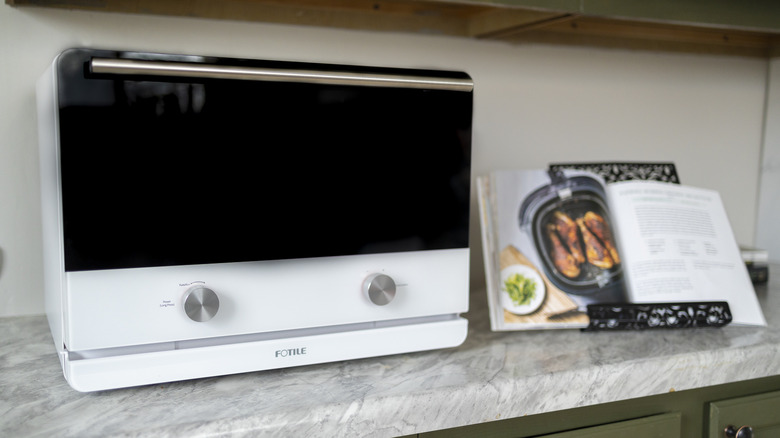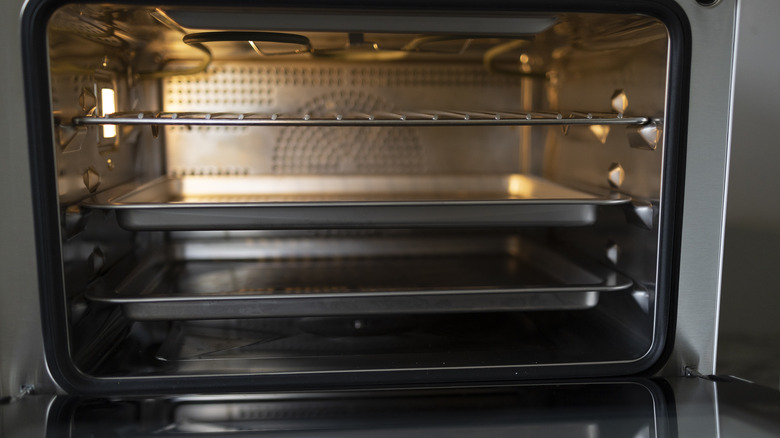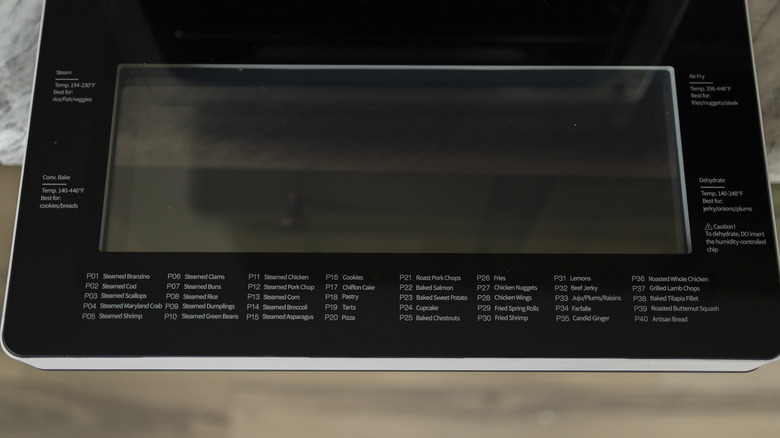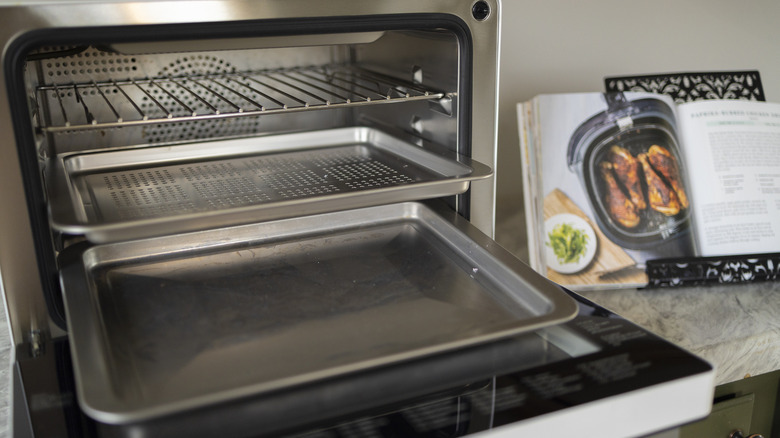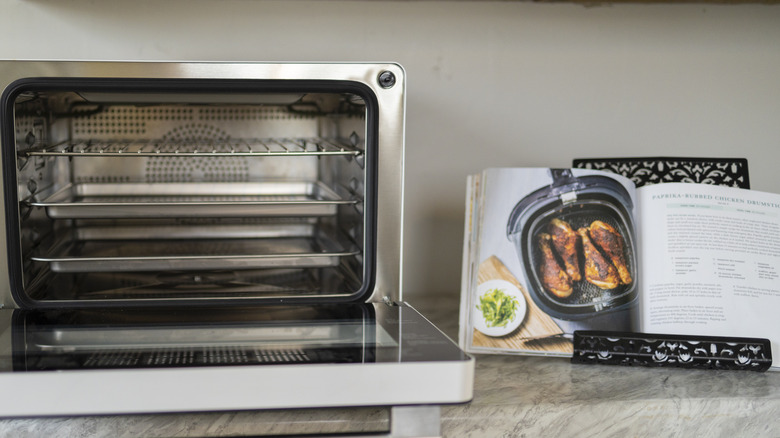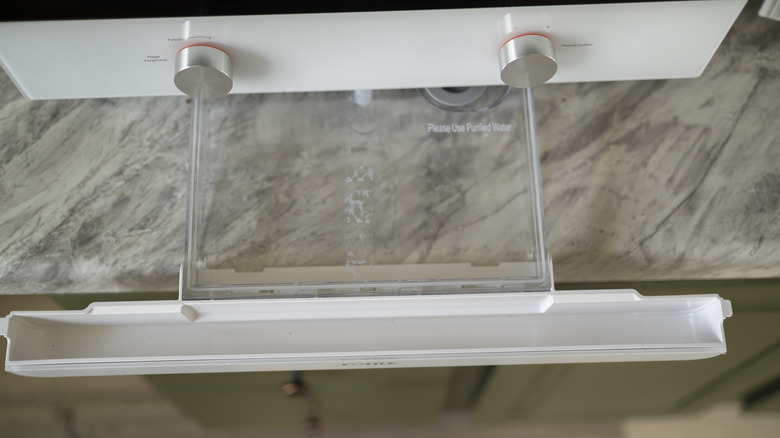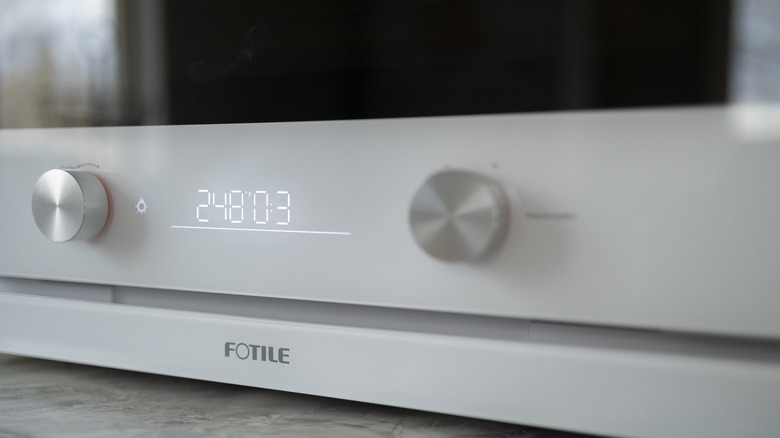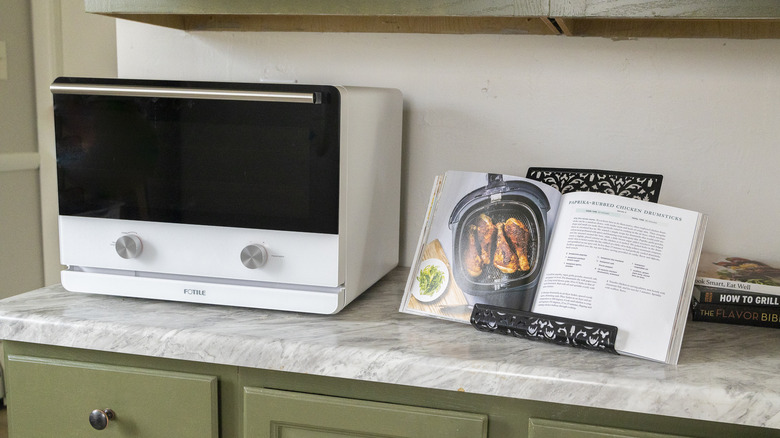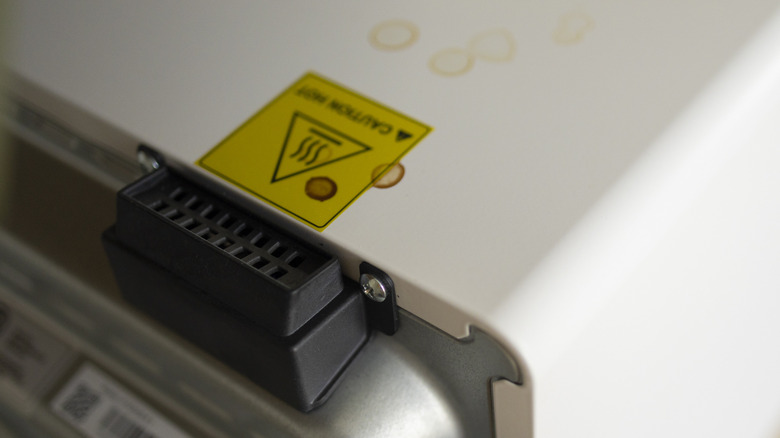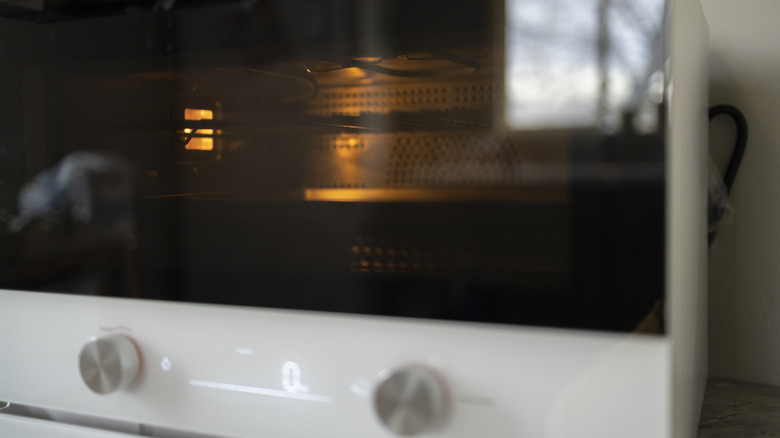Fotile ChefCubii E1 Review: Countertop Steam Oven Convenience With Compromise
- Large oven capacity
- Tons of useful preset functions
- Sleek, pleasing design
- Self-cleaning mode
- Catered to cooking in Celsius
- Vent location isn't ideal
- Baking capability is flawed
We may receive a commission on purchases made from links.
My kitchen countertops are precious real estate — a sentiment I'm sure many people share. To land in my permanent small appliance domain, a new gadget or gizmo has a lot of proving itself to do. And of those new kitchen gadgets and gizmos, there is no shortage; there's always something new that claims to offer even more convenience, to solve a cooking annoyance we didn't even know we had.
The ChefCubii Countertop Steam Oven (model HYZK26-E1) is such a gadget. It's different from an air fryer, more than a microwave, a sibling to the toaster oven — and definitely another appliance vying for your favor as the most valuable utility on your kitchen counter. It offers multiple cooking functions, an impressive suite of preset cooking modes, and a sleek, visually-pleasing design. But do all of these claims solidify when you put the oven to work, and is it worthy of the space it consumes? Fotile provided me with a countertop steam oven for the purpose of this review.
Design and setup
The 30-quart, 1550-Watt ChefCubii oven comes in a sleek, white design and stands 2 feet tall, 18.8 inches wide, and 17.8 inches deep — I had plenty of vertical clearance under my cabinets to fit the oven. Included with the oven are the following: a wire baking rack, a regular baking sheet, a perforated baking sheet, a humidity control chip for dehydrating, and an oven mitt.
My immediate thought, as may be yours, is if additional racks and sheets are available for purchase directly from the manufacturer, for when you want to use two regular baking sheets or two grilling racks at a time. Unfortunately, as far as I can tell, the answer is no.
The oven is equipped with two control knobs, interior lights, triple-layered insulation on the door, a water reservoir for steaming, and a vent in the top-back corner. Setting up the ChefCubii was simple — just plug it in and run it through the 20-minute cleaning cycle with all the trays inside as described in the user manual.
The suite of functions
There are four primary functions of the ChefCubii: steam, convection bake, dehydrate, and air fry. Ancillary functions include grilling, reheating, toasting, rice cooking, and proofing. Fotile takes it one step further to offer you 40 specific food cooking presets. Many of them are useful, but some are a bit unexpected — like having functions specifically for "Chiffon Cake," "Maryland Crabs" (no crabs from anywhere else, huh?), "Cupcake" (only one?), or just, vaguely, "Lemons."
The oven is remarkably easy to control by navigating with the two knobs, but one thing that I found to be annoying is that the oven was not geared up well for Fahrenheit cooking. The temperature moves up in increments of four degrees when set to Fahrenheit, and doesn't land evenly on common baking temperatures — so you can't cook at 275, 350, 400 degrees, and so forth. I think for most things it probably won't make much of a difference, but it was still aggravating.
A half-rack of ribs and a whole roast chicken
I used the ChefCubii 14 times, over a couple of weeks, to test it for this review. Here's everything I covered: large cuts of meat (a half-rack of ribs, a whole young chicken), smaller cuts of meat (steaks, chicken drumsticks), reheating leftovers (pasta), steamed foods (fish plus vegetables, frozen dumplings), air fryer specialties (chicken nuggets plus French fries, corn dogs), dehydrated snacks (beef jerky, banana chips), toasting (slices of bread plus bagels), proofing (pastry dough), and baking (cookie dough).
For my large cuts of meat tests, I knew that the biggest issue of course is going to be space. Normally, when I roast a chicken, I do it in a roasting pan in the oven — which allows plenty of space for potatoes, onions, carrots, broth, herbs, etc. But since you've only got a baking sheet at your disposal here, you lose out on all of that. However, I used the oven's "roasted whole chicken" preset and the chicken did turn out beautifully, with moist white meat and crispy skin.
Getting the chicken out of the oven was incredibly precarious, though, because the baking sheet is a bit jerky and jolty when sliding out. Combine that with the boiling-hot chicken juice that had run off into the shallow pan, I was one wrong tilt away from scorching myself — which I naturally did, repeatedly.
A half-rack of ribs was just a rib or two too long for the baking sheet, forcing me to cut them. They cooked up alright, although I'd still choose to smoke ribs any day over baking them. All in all, the oven handles the actual cooking of large meat cuts just fine, but logistically it's not perfect.
Smaller cuts of meat
I didn't have any chicken wings on hand to test that cut of meat's preset, but I did use it for chicken drumsticks instead. Because I was concerned about repeating the third-degree burns from the roasted whole chicken experiment, I poked the drumstick ends through the grates of the wire grilling rack and let them hang upside down to cook, so that the juice would drip off onto the baking sheet below. This let me take the runoff out later after it had cooled off. Set at the chicken wing setting, the drumsticks cooked up remarkably well — they had to run through for a few more minutes to get to temp, but overall it confirmed my hope that the highly-specific presets can be applied to adjacent foods, like chicken drumsticks instead of wings.
I was skeptical of the machine's claim to offer grilling capability, so I put that to the test with a ribeye. You'd think that this would be an obvious preset to include on the oven — but to my chagrin, it wasn't. There aren't presets for beef at all, besides the beef jerky.
Normally, if I'm to make a steak indoors, I sear it on hot cast iron and then pop it in the oven. Putting cast iron into the countertop oven didn't seem prudent, so instead I tried to get a sear on the steak by putting it directly on the oven grate after it had preheated. This didn't work very well, so I wouldn't recommend using the ChefCubii for steaks (or any cut of meat on which you'd like a crusty sear).
Overall, I'd say the ChefCubii is capable of cooking most meats. I also want to mention that I had a wired meat thermometer in the oven, and the door still closed and sealed tightly around the wire.
Reheating pasta and cooking steamed foods
There are two potential impracticalities to reheating leftovers in the countertop oven: You need to have a collection of small, oven-safe dishes, and you also need to be willing to spend three times as long waiting for your leftovers as you would if they were microwaved. The oven does take a good five minutes or so to preheat, plus the time to heat up your food — you're looking at about 10 minutes just to reheat a bowl of pasta. Unless you have any physiological objections to using a microwave á la Cousin Eddie from "Christmas Vacation," are reheating a family-sized amount of leftovers, or are reheating something that needs to be crisped back up like fried foods, it's not the most practical application in the world.
And for the next test, steaming food, I first tried pre-packaged, frozen dumplings, then later tried a steamed tilapia filet with broccoli and carrots. I used the preset dumplings option for the former, and the preset steamed broccoli option for the entire meal in the latter. Everything came out flawlessly made.
I don't think there's any way that something that can be steamed remarkably, but this oven does it very well, and cleaning up the used water afterward is hassle-free. In order to use the steam function, the water reservoir on the bottom of the oven (pictured) must be filled. The spent water is then discharged into the collection tray, which is the white piece towards the front.
Air frying, dehydrating, and toasting
With air frying and toasting we see a convenience fallacy similar to reheating leftovers: How is booting up this oven any more convenient than dropping a piece of bread in a toaster or dumping chicken nuggets in the basket of an air fryer? And the short, easy answer is that it's not. Given that I was doing all of this cooking, I had a couple of guests over to help taste test the experiments — and there began a lively debate about which appliances a countertop oven like the ChefCubii is meant to usurp. If you replace a microwave with this oven, the privilege of fast cooking from an air fryer and convenience foods like microwave popcorn are revoked. But giving up the ease of a toaster seems outrageous, too.
The countertop oven "air fries" breaded frozen food or fried leftovers as well as any other air fryer, again with the sacrifice of time. But there's no easy preset for toasting bread — another missed preset opportunity, in my opinion. You have to do a lot of fine-tuning to achieve the right temp and time for your desired toastiness — and might blacken a bagel or two in the process. Now that I've gotten the hang of it, I do think I could be convinced to replace a toaster with this oven, but it was a very rough start.
Dehydrating with the ChefCubii was a breeze. Preparing food for dehydration is the trickiest part, regardless of the appliance. My only complaint is, again, that I only have one baking tray — so dehydrating in the ChefCubii occurs in very small batches, compared to my four-leveled dedicated dehydrator.
Proofing and baking
The ChefCubii is excellent for proofing dough. Its compact size retains heat and moisture well, creating ideal scenarios for proofing my pastry dough. The light makes it easy to check on your dough's rising progress, too. Unfortunately, baking thereafter started to fall flat — literally. Despite creating a beautifully-proofed dough, my pastries came out of the ChefCubii burnt black on the bottom and dense/chewy throughout. All of that rise and dimension was somehow lost.
I struggled with getting decent cookies out of the prepackaged cookie dough I tested, too. The texture was wildly inconsistent from one cookie to the next — the ones towards the back of the oven were crunchy and dark, and the ones towards the top were soft and underdone in the middle.
I do think that part of this oven's unimpressive baking performance can be blamed on the often-rocky transition from conventional baking to convection baking, especially convection baking in a compact appliance designed to bake things quickly. Regardless, Fotile's preset modes offered little guidance in this matter — and in fact, I was shocked that the manufacturer didn't include a recipe book or baking guide.
Auxiliary parts would be nice
Now's a good time to complain about the vent. This issue was most prevalent with the steaming function but happened anytime the oven ran for more than 15 minutes or so (which was nearly every time). I don't think there's any completely optimal location for discharging the hot steam, but since the oven's vent is on top, all of that warm moisture is sent up to the underside of my cabinet.
There, it condenses and drips back on to oven, bringing some very unappealing grime, mineral buildup, and wood stain with it, as pictured. I can't imagine that the repeated steam accumulation would be healthy for my cabinets in the long term had I purchased this for long-term use, but there's no easy way to divert it. In summary, I think Fotile needs to sell accessories for its oven: more trays, and some sort of vent tubing/diversion system.
Is the Fotile ChefCubii worth it?
ChefCubii falls in the middle of the road with regard to affordability; it is currently on sale for $399.00 on Amazon, off the listed price of $499.00. In contrast, Ninja makes a countertop oven that will cost you $299.99 at Target. KitchenAid's version is more affordable, too, at around $220 at Best Buy. As a consumer, I would default those brands that I know very well and probably get a very comparable if not better experience than I had with the ChefCubii from Fotile.
It seems that the Fotile product wants to compete with more advanced, gourmet countertop ovens — there's one by Wolf that'll run you nearly $750 at Williams-Sonoma — but lacks the refinement needed to earn a place in that circle.
However, the oven is incredibly quiet — barely audible even while I was standing in the kitchen — and insanely easy to wipe out after running the self-cleaning cycle. It mostly does what it claims to be capable of. While I struggle to recommend this oven over cheaper, more well-known alternatives, it wouldn't be an entirely sunk investment if you wanted to choose this oven for its aesthetic appeal, user-friendliness, or large capacity.
